Liposome Drug Delivery Market Size and Trends
The liposome drug delivery market is estimated to be valued at USD 5,981.6 Mn in 2025 and is expected to reach USD 11,012.1 Mn by 2032, exhibiting a compound annual growth rate (CAGR) of 9.1% from 2025 to 2032.
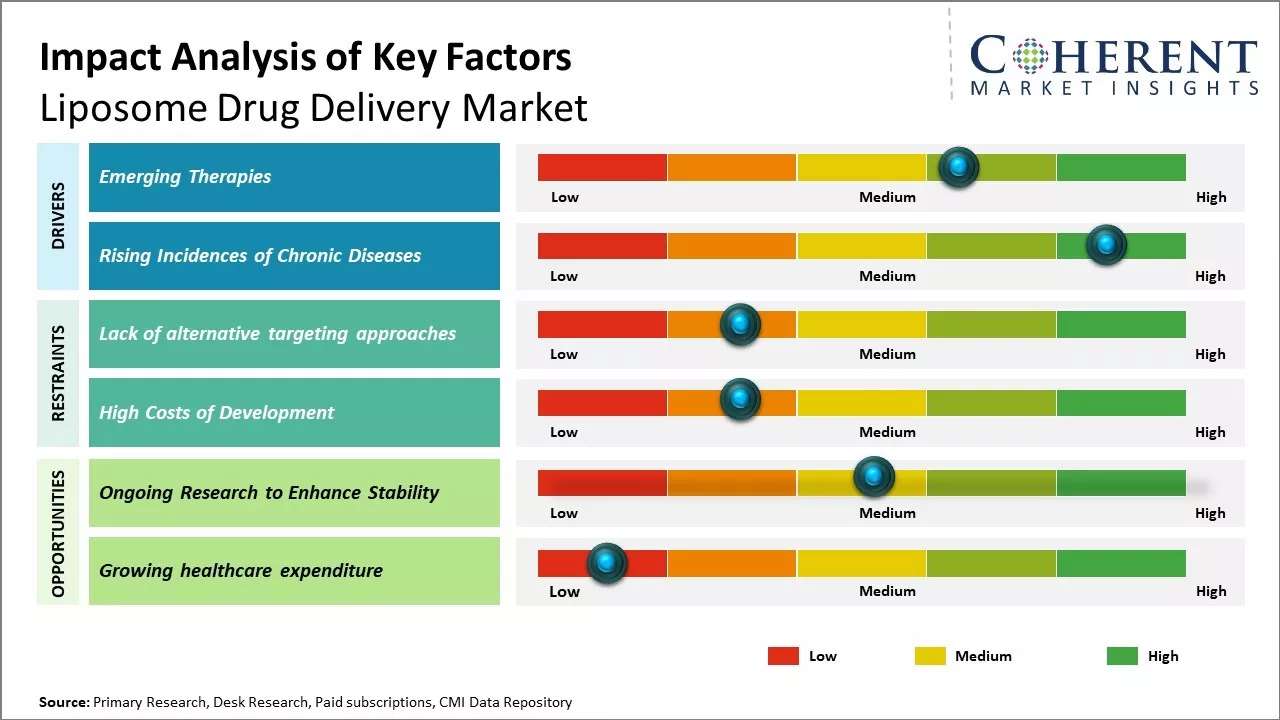
Discover market dynamics shaping the industry: Download Free Sample
The liposome drug delivery market is expected to witness lucrative growth over the forecast period. This is mainly attributed to increasing demand for advanced drug delivery systems and targeted drug delivery. Liposomes have emerged as a viable drug carrier due to their ability to encapsulate both hydrophilic and hydrophobic drug molecules and release them in a controlled manner. These liposomal formulations enhance drug solubility, bioavailability, and stability while reducing toxicity. Using liposomes as drug carriers helps minimize side effects and overcome multi-drug resistance associated with conventional chemotherapy. Several liposomal drugs have been approved for cancer treatment and many more are in clinical trial stages, indicating robust growth opportunities over the coming years.
Rising Incidences of Chronic Diseases
The increasing prevalence of chronic diseases across the globe has significantly boosted demand for more effective drug delivery systems. Conventional drug delivery methods often face challenges in efficiently delivering medications to the target sites for many chronic health conditions. Liposomes present a promising solution given their unique properties to encapsulate both hydrophobic and hydrophilic drug molecules and transport them across biological membranes. Chronic diseases such as cancer, cardiovascular ailments, and neurological disorders are posing a huge burden on individuals and healthcare systems. It is estimated that over 50% of adults in developed nations suffer from at least one chronic disease. These diseases usually require long-term or even lifetime treatment often comprising multiple drugs. Ensuring compliance and delivering the right dose of drugs to affected tissues can be challenging with conventional delivery methods. Liposomes address this need by allowing targeted and controlled release of encapsulated drugs. Their nanoparticle size facilitates penetration through biological barriers like cell membranes. Functionalization of liposomes with ligands permits active targeting to diseased sites. Controlled release kinetics via stimuli-responsive mechanisms prevents premature drug leakage.
Market Concentration and Competitive Landscape
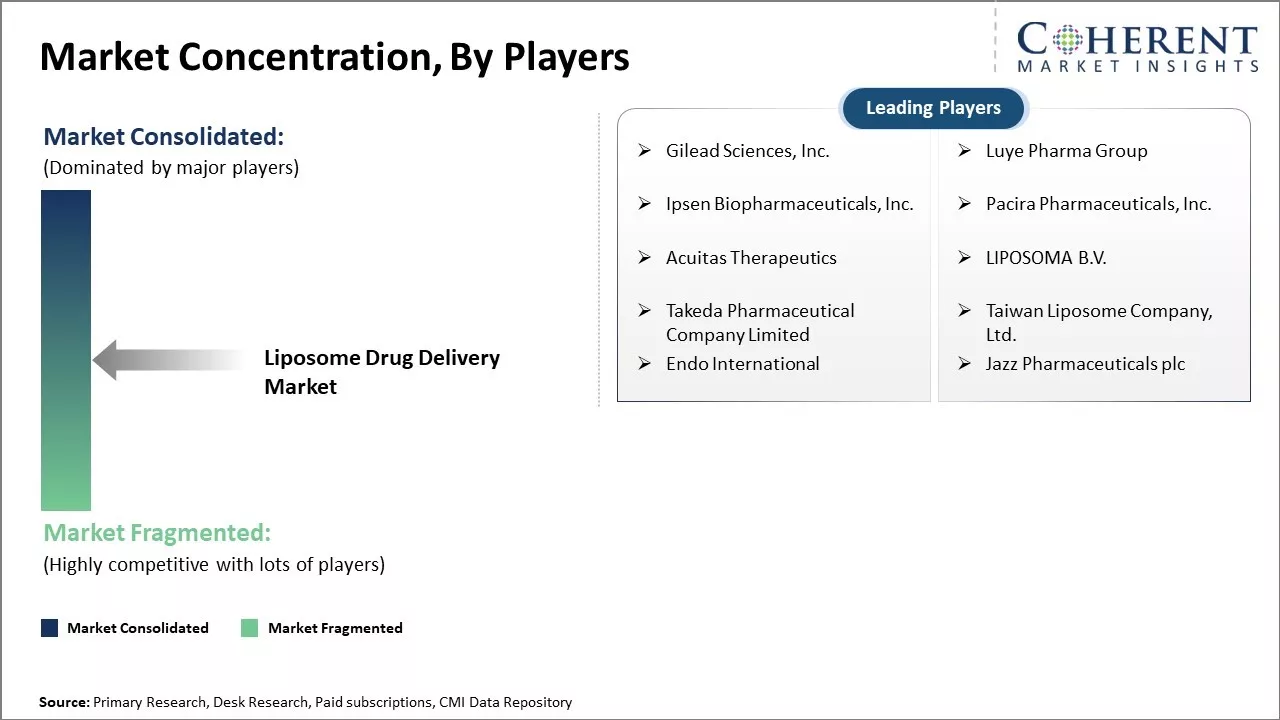
Get actionable strategies to beat competition: Download Free Sample
Emerging TherapiesThe constant flow of new molecular entities and therapeutic modalities is opening up sweeping opportunities for innovative drug delivery strategies. Several cutting-edge therapies, such as gene therapy, immunotherapy, and tissue engineering, are highlighting the indispensable role of effective delivery systems. While formidable in potential, these new treatment paradigms also present complex formulation and administration puzzles that demand ingenious solutions. Liposomes here offer a uniquely qualified delivery platform ready to power the next generation medical innovations. Groundbreaking technologies to alter cellular physiology, eradicate diseases, and repair tissues are transforming healthcare outlooks. Gene therapies for inherited disorders, cell therapies for regenerative medicine, and cytokine-based immunotherapies for cancer possess immense lifesaving capabilities. However, their clinical translation requires overcoming large molecular
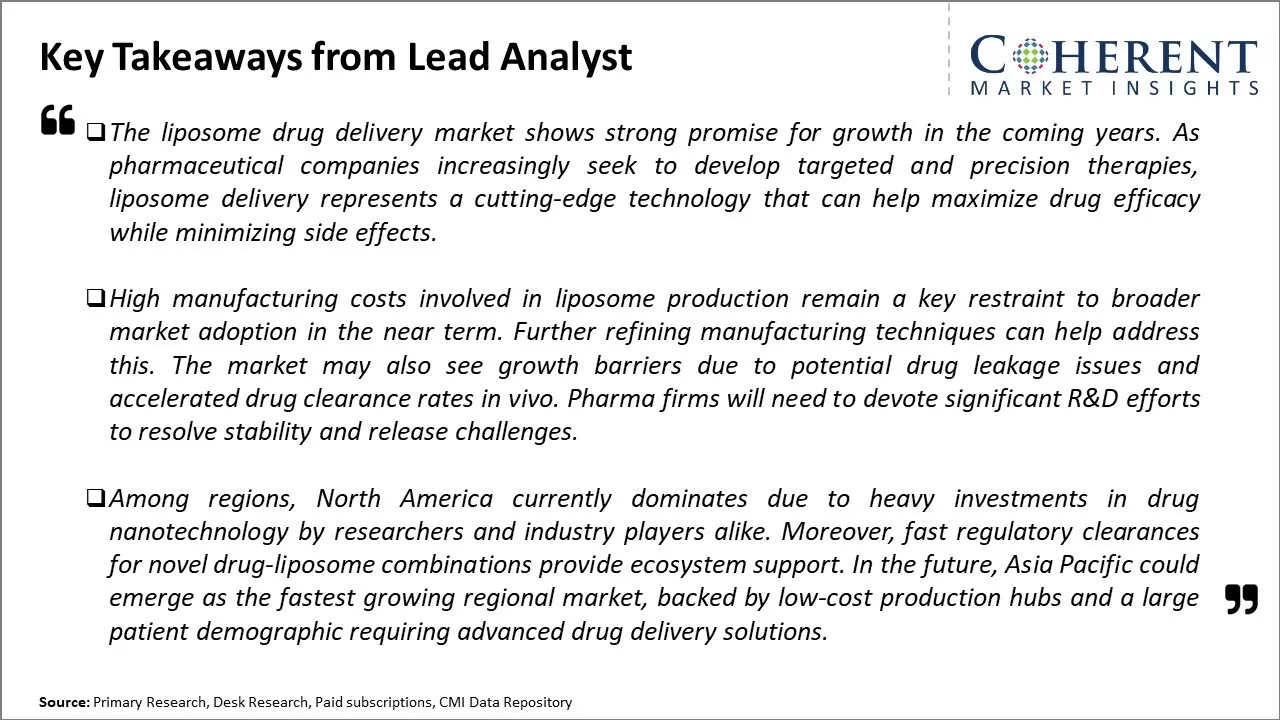
To learn more about this report, Download Free Sample
Market Challenges – High Costs of DevelopmentThe liposome drug delivery market faces several challenges. The high cost of development acts as a deterrent for smaller pharmaceutical companies. Additionally, the instability of liposomes during storage and circulation poses regulatory hurdles. Their large size limits their use for targeting certain organs. Drug leakage during circulation also reduces the amount of drug reaching the target site.
Market Opportunities – Ongoing Research to Enhance Stability
The liposome drug delivery market also presents multiple opportunities. The ability of liposomes to encapsulate both hydrophobic and hydrophilic drugs expands the range of treatable diseases. Ongoing research to enhance stability, modify surface properties for effective targeting, and introduce triggered release could help address current challenges. New application areas like gene therapy offer scope for further innovation.
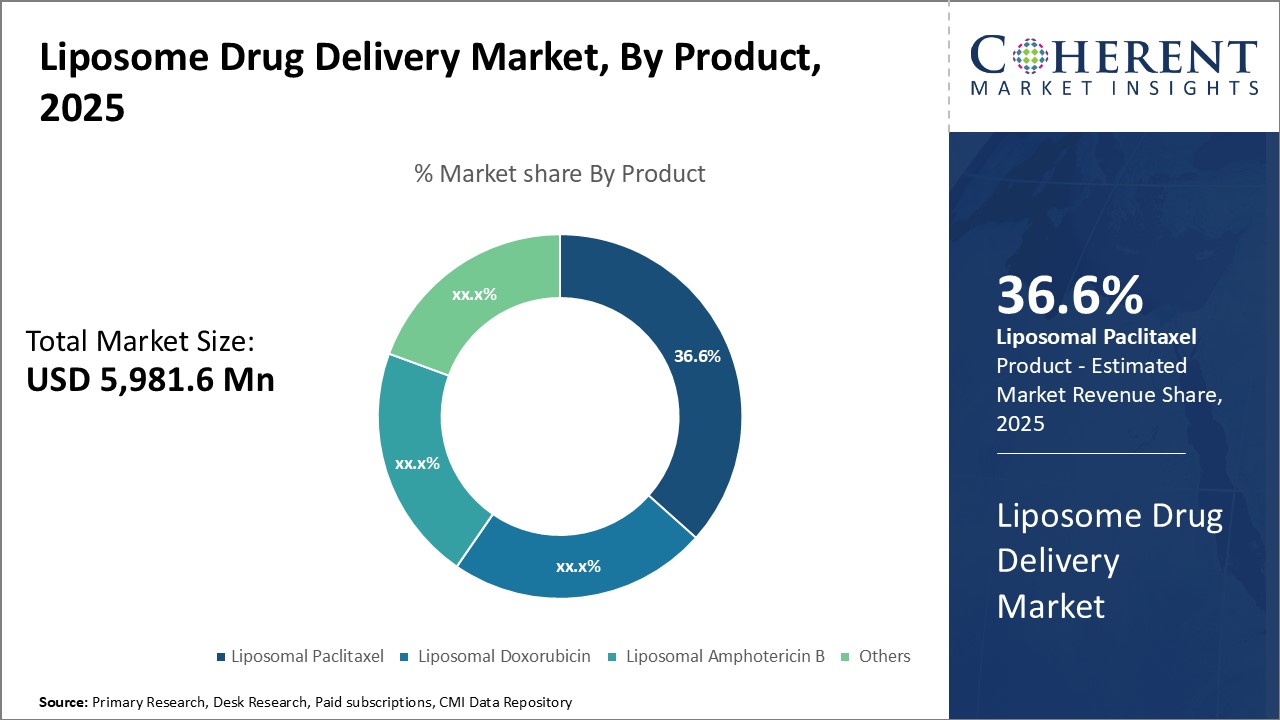
Discover high revenue pocket segments and roadmap to it: Download Free Sample
Insights, By Product: Targeted Delivery Drives Growth of Liposomal DoxorubicinThe product segment includes liposomal paclitaxel, liposomal doxorubicin, liposomal amphotericin B, and others. The liposomal doxorubicin segment is estimated to hold 36.6% share of the market in 2025 owing to its targeted delivery capabilities. Doxorubicin is an effective chemotherapy drug but its use is limited by dose-dependent cardiac toxicity. Encapsulating doxorubicin inside a liposome allows it to be delivered directly to tumor sites while avoiding healthy tissues. This targeted delivery significantly reduces toxicity compared to conventional doxorubicin. Liposomal doxorubicin's encapsulation protects the drug from degradation until it reaches the tumor. Once there, the drug payload is released inside cancer cells through degradation of the liposome membrane. This prolonged circulation time and controlled release at tumor sites maximizes doxorubicin concentrations where they are needed most. The targeted delivery greatly enhances the therapeutic index of doxorubicin and allows effective treatment at doses that otherwise could not be tolerated.
Insights, By Technology: Stealth Technology Leads in Drug Shielding
The technology segment includes stealth liposome technology, non-PEGylated liposome technology, and DepoFoam liposome technology. The stealth liposome technology sub-segment is expected to hold 43.2% of the market share in 2025 owing to its superior drug encapsulation abilities. Stealth liposomes modify the membrane with hydrophilic polymers like PEG to reduce uptake by the mononuclear phagocyte system. This “masks” the liposome from the immune system, increasing circulation time up to 72 hours versus a few minutes for conventional liposomes. The longer circulation duration gives stealth liposomes greater opportunity to accumulate selectively at tumor sites versus healthy tissues. It also allows for release of higher concentrations of the drug payload intracellularly over an extended period versus a single burst. This passive targeting via the enhanced permeability and retention effect maximizes drug accumulation precisely where needed.
Insights, By Indication: Growth in Ambulatory Surgeries Boosts Demand
The indication segment includes fungal diseases, pain management, cancer therapeutics, and others. The cancer therapeutics sub-segment is expected to account for 54.2% of the market share in 2025. This dominant position stems from the high incidence and prevalence of various types of cancer worldwide. Cancer accounts for nearly one in six deaths globally, with over 20 million new cases and 10 million cancer deaths reported each year. The growing cancer burden can be attributed to several factors such as aging populations, changing lifestyles resulting in obesity and lack of physical activity, and exposure to carcinogens such as tobacco smoke. While advancements in early detection and treatment have helped push up survival rates for certain cancer types, there remains an immense unmet need for developing more effective and targeted therapies. It is here that liposome drug delivery demonstrates considerable promise. By encapsulating anti-cancer drugs in liposomes, these nanocarriers can selectively deliver higher concentrations of medication to tumor sites while avoiding healthy tissues. This results in improved efficacy and fewer side effects for patients undergoing chemotherapy. Some examples of liposomal cancer medications that have witnessed success include Doxil, Liposomal Daunorubicin, and others.
Regional Insights
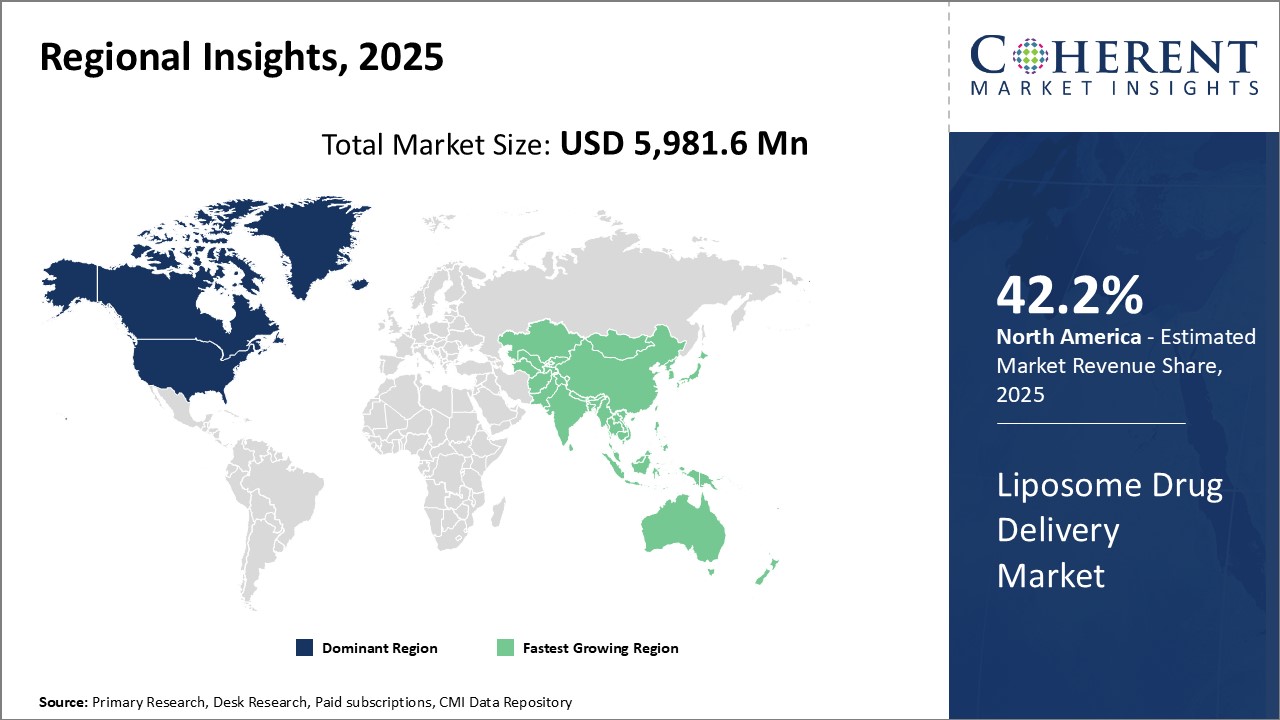
Need a Different Region or Segment? Download Free Sample
North America remains the dominant region in the global liposome drug delivery market and is anticipated to hold 42.2% of the market share in 2025. North America has established itself as the leading regional market for liposome drug delivery. The major factor driving its prominence is the strong presence of leading pharmaceutical and biotechnology companies in the U.S. and Canada. American companies like Gilead Sciences, Jazz Pharmaceuticals, and Acrotech Biopharma have been pioneering the research and development of novel liposomal drugs for critical therapies like cancer. Supportive regulatory environment provided by U.S. Food and drug Administration has encouraged clinical trials and approvals of many liposomal formulations over the past decade. Additionally, high healthcare spending, and availability of advanced medical facilities have enabled faster adoption of innovative liposomal drugs. Leading U.S.-based pharmaceutical companies also actively engage in contract manufacturing and licensing deals to cater liposomal drugs globally.
The Asia Pacific region, primarily driven by China and India, is emerging as the fastest growing regional market. Both the countries have witnessed significant growth in their pharmaceutical industries over the last few years. Many domestic Chinese and Indian companies are now engaged in the development and manufacturing of generic liposomal drugs. Growing expertise in areas like nanotechnology and pharmaceutical production has boosted their capabilities. Low manufacturing and labor costs provide Asia Pacific companies a competitive edge in the global liposome drug delivery market. Several leading multinational pharmaceutical companies have also established manufacturing bases in China and contract local players for supply of liposomal drugs worldwide. Rising income levels and expanding medical insurance coverage are increasing access to innovative therapies in major Asian countries. Their governments also support local R&D through funding and relaxed regulatory norms to encourage drug innovation.
Market Report Scope
Liposome Drug Delivery Market Report Coverage
| Report Coverage | Details | ||
|---|---|---|---|
| Base Year: | 2024 | Market Size in 2025: | USD 5,981.6 Mn |
| Historical Data for: | 2020 To 2024 | Forecast Period: | 2025 To 2032 |
| Forecast Period 2025 to 2032 CAGR: | 9.1% | 2032 Value Projection: | USD 11,012.1 Mn |
| Geographies covered: |
|
||
| Segments covered: |
|
||
| Companies covered: |
Gilead Sciences, Inc., Luye Pharma Group, Ipsen Biopharmaceuticals, Inc., Pacira Pharmaceuticals, Inc., Acuitas Therapeutics, LIPOSOMA B.V., Takeda Pharmaceutical Company Limited, Taiwan Liposome Company, Ltd., Endo International, and Jazz Pharmaceuticals plc |
||
| Growth Drivers: |
|
||
| Restraints & Challenges: |
|
||
Uncover macros and micros vetted on 75+ parameters: Get instant access to report
Liposome Drug Delivery Industry News
- On February 13, 2024, Ipsen Biopharmaceuticals, Inc., a global biopharmaceutical company, announced that the U.S. Food and Drug Administration (FDA) has approved irinotecan liposome (Onivyde) for the first-line treatment of metastatic pancreatic adenocarcinoma
- In March 2021, Jazz Pharmaceuticals plc, a pharmaceutical company, announced that the U.S. Food and Drug Administration (FDA) approved a revised label for Vyxeos (daunorubicin and cytarabine) to include a new indication to treat newly-diagnosed therapy-related acute myeloid leukemia (t-AML) or AML with myelodysplasia-related changes (AML-MRC) in pediatric patients aged one year and older. Vyxeos is a liposomal combination of daunorubicin, an anthracycline topoisomerase inhibitor, and cytarabine, a nucleoside metabolic inhibitor.
*Definition: Liposomes are lipid vesicles that have revolutionized drug delivery by enhancing the stability of therapeutic compounds, improving biodistribution to target sites, and minimizing systemic toxicity. These nanocarriers can encapsulate both lipophilic and hydrophilic compounds, making them versatile for drug delivery applications. They are used for a wide range of therapeutic compounds, gene therapy, and bioactive agents, with modifications constantly being explored to enhance efficacy and reduce toxicity.
Market Segmentation
- Product Insights (Revenue, USD Mn, 2020 - 2032)
- Liposomal Paclitaxel
- Lsiposomal Doxorubicin
- Liposomal Amphotericin B
- Others
- Technology Insights (Revenue, USD Mn, 2020 - 2032)
- Stealth Liposome Technology
- Non-PEGylated Liposome Technology
- DepoFoam Liposome Technology
- Indication Insights (Revenue, USD Mn, 2020 - 2032)
- Fungal Diseases
- Pain Management
- Cancer Therapeutics
- Others
- End User Insights (Revenue, USD Mn, 2020 - 2032)
- Hospitals
- Clinics
- Research Laboratories
- Others
- Regional Insights (Revenue, USD Mn, 2020 - 2032)
- North America
- U.S.
- Canada
- Latin America
- Brazil
- Argentina
- Mexico
- Rest of Latin America
- Europe
- Germany
- U.K.
- Spain
- France
- Italy
- Russia
- Rest of Europe
- Asia Pacific
- China
- India
- Japan
- Australia
- South Korea
- ASEAN
- Rest of Asia Pacific
- Middle East
- GCC Countries
- Israel
- Rest of Middle East
- Africa
- South Africa
- North Africa
- Central Africa
- North America
- Key Players Insights
- Gilead Sciences, Inc.
- Luye Pharma Group
- Ipsen Biopharmaceuticals, Inc.
- Pacira Pharmaceuticals, Inc.
- Acuitas Therapeutics
- LIPOSOMA B.V.
- Takeda Pharmaceutical Company Limited
- Taiwan Liposome Company, Ltd.
- Endo International
- Jazz Pharmaceuticals plc
Share
Share
About Author
Ghanshyam Shrivastava - With over 20 years of experience in the management consulting and research, Ghanshyam Shrivastava serves as a Principal Consultant, bringing extensive expertise in biologics and biosimilars. His primary expertise lies in areas such as market entry and expansion strategy, competitive intelligence, and strategic transformation across diversified portfolio of various drugs used for different therapeutic category and APIs. He excels at identifying key challenges faced by clients and providing robust solutions to enhance their strategic decision-making capabilities. His comprehensive understanding of the market ensures valuable contributions to research reports and business decisions.
Ghanshyam is a sought-after speaker at industry conferences and contributes to various publications on pharma industry.
Missing comfort of reading report in your local language? Find your preferred language :
Transform your Strategy with Exclusive Trending Reports :
Frequently Asked Questions
EXISTING CLIENTELE
Joining thousands of companies around the world committed to making the Excellent Business Solutions.
View All Our Clients
